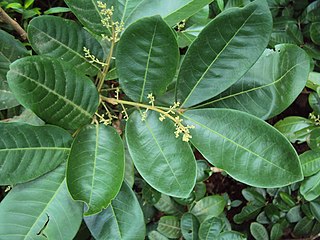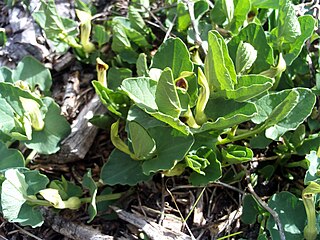
Dimocarpus longan, commonly known as the longan and dragon's eye, is a tropical tree species that produces edible fruit. It is one of the better-known tropical members of the soapberry family Sapindaceae, to which the lychee and rambutan also belong. The fruit of the longan is similar to that of the lychee, but less aromatic in taste. It is native to tropical Asia and China.

Sassafras is a genus of three extant and one extinct species of deciduous trees in the family Lauraceae, native to eastern North America and eastern Asia. The genus is distinguished by its aromatic properties, which have made the tree useful to humans.

Viola odorata is a species of flowering plant in the family Violaceae, native to Europe and Asia. This small hardy herbaceous perennial is commonly known as wood violet, sweet violet, English violet, common violet, florist's violet, or garden violet. It has been introduced into the Americas and Australia.

Aglaia is a genus of 117 species of woody dioecious trees belonging to the Mahogany family (Meliaceae). These trees occur in the subtropical and tropical forests of Southeast Asia, Northern Australia and the Pacific.

Baccaurea ramiflora, the Burmese grape, is a slow-growing evergreen tree in the family Phyllanthaceae, growing to 25 m, with a spreading crown and thin bark. It is native to Asia, from Nepal in the west, east to southern China and south to Peninsular Malaysia. It grows in evergreen forests on a wide range of soils. The fruit is harvested and used locally, eaten as a fruit, stewed or made into wine; it is also used medicinally to treat skin diseases. The bark, roots and wood are harvested for medicinal uses.

Ipomoea aquatica, widely known as water spinach, is a semi-aquatic, tropical plant grown as a vegetable for its tender shoots. I. aquatica is generally believed to have been first domesticated in Southeast Asia. It is widely cultivated in Southeast Asia, East Asia, and South Asia. It grows abundantly near waterways and requires little to no care.

Platycodon grandiflorus is a species of herbaceous flowering perennial plant of the family Campanulaceae, and the only member of the genus Platycodon. It is native to East Asia. It is commonly known as balloon flower, Chinese bellflower, or platycodon.

Prunella vulgaris, the common self-heal, heal-all, woundwort, heart-of-the-earth, carpenter's herb, brownwort or blue curls, is an herbaceous plant in the mint family Lamiaceae.

Aglaia lawii is a species of tree in the family Meliaceae. As well as the autonym species, there are two subspecies accepted.

Aglaia rimosa is an evergreen small tree in the family Meliaceae. It is found in Indonesia, Papua New Guinea, the Philippines, and Taiwan. Aglaia rimosa "grows primarily in the wet tropical biome".The official name of Aglaia rimosa in Taiwan is Large-leaved aglaia, because compared with the other two species native to Taiwan, Aglaia elaeagnoidea and Aglaias chittagonga, the leaflet of Aglaia rimosa is larger than their leaflet, all three are imparipinnate.The flowers of Aglaia rimosa have fragrance, but it is lighter than that of Aglaia odorata.The anticancer compound Rocaglamide (RocA) was originally extracted from Aglaia rimosa by researchers in Taiwan.

Aquilaria sinensis is a species of plant in the family Thymelaeaceae. It is endemic to China. It is threatened by habitat loss. This medicinal plant is a source of fragrant wood, formed under a pathological condition, called Chen Xiang in Standard Mandarin, or chàhm hēung in Cantonese, or agarwood.

Nymphaea odorata, also known as the American white waterlily, fragrant water-lily, beaver root, fragrant white water lily, white water lily, sweet-scented white water lily, and sweet-scented water lily, is an aquatic plant belonging to the genus Nymphaea. It can commonly be found in shallow lakes, ponds, and permanent slow moving waters throughout North America where it ranges from Central America to northern Canada. It is also reported from Brazil and Guyana.

Myrica cerifera is a small evergreen tree or large shrub native to North and Central America and the Caribbean. Its common names include southern wax myrtle, southern bayberry, candleberry, bayberry tree, and tallow shrub. It has uses in the garden and for candlemaking, as well as a medicinal plant.

Chamaemelum nobile, commonly known as chamomile, is a low perennial plant found in dry fields and around gardens and cultivated grounds in Europe, North America, and South America. Its synonym is Anthemis nobilis, with various common names, such as Roman chamomile, English chamomile, garden chamomile, ground apple, low chamomile, mother's daisy or whig plant. C. nobile is a source of the herbal product known as chamomile using dried flowers for flavoring teas or as a fragrance used in aromatherapy. Chamomile has no established medicinal properties.

Nymphaea nouchali, often known by its synonym Nymphaea stellata, or by common names blue lotus, star lotus, red water lily, dwarf aquarium lily, blue water lily, blue star water lily or manel flower, is a water lily of genus Nymphaea. It is native to southern and eastern parts of Asia, and is the national flower of Bangladesh and Sri Lanka. In Sanskrit it is called utpala. This species is usually considered to include the blue Egyptian lotus N. nouchali var. caerulea. In the past, taxonomic confusion has occurred, with the name Nymphaea nouchali incorrectly applied to Nymphaea pubescens.

Acronychia pedunculata is a large shrub or small tree of the understory, gaps and fringes of low country and lower hill tropical forests of tropical Asia.

Angelica dahurica, commonly known as Dahurian angelica, is a widely grown species of angelica native to Siberia, Russia Far East, Mongolia, Northeastern China, Japan, Korea, and Taiwan. This species tend to grow near river banks, along streams and among rocky shrubs. The root of the plant is widely used for its medicinal properties and is known to contain furanocoumarins and angelicotoxin.

Angelica acutiloba is a perennial herb from the family Apiaceae or Umbelliferous. It is predominately in Japan and perhaps endemic (unique). It is now distributed widely and cultivated in Jilin, China, Korea, Taiwan and Indonesia.
This is a list of plants used by the indigenous people of North America. For lists pertaining specifically to the Cherokee, Iroquois, Navajo, and Zuni, see Cherokee ethnobotany, Iroquois ethnobotany, Navajo ethnobotany, and Zuni ethnobotany.

Aristolochia paucinervis is a herbaceous plant in the family Aristolochiaceae endemic to the western Mediterranean Basin.





















